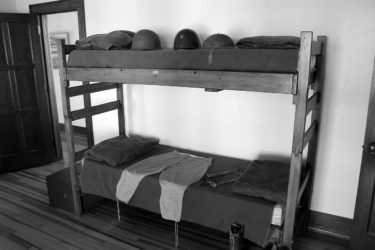
As a writer, I look forward to my weekly New Yorker. The essays are timely and beautifully written. I know that they’re accurate because the fact-checkers at the New Yorker are famously compulsive, to the despair of some contributors. The magazine is a writer’s joy.
Just as appealing as the articles are the New Yorker’s famous cartoons. For a writer of humor, the cartoonist is a kindred spirit.
One of the magazine’s most renowned cartoonists is George Booth. Booth’s grumpy pit bull has been a regular on its pages for over forty years. A cartoonist in his eighties who still sits at his drawing board daily and laughs aloud at his own work, Booth’s favorite themes are cats and dogs, yard sales, goofy rural couples, and incompetent car mechanics working in dog-infested garages. Looking aggrieved, the dog often sits in a room with wrinkled carpets, rickety furniture, and a crotchety old couple. A naked light bulb dangles from the ceiling in this example.
Booth grew up in rural Missouri with his schoolteacher parents. His mother was also an accomplished artist and musician. After high school, Booth attended several art schools but never stayed long enough to graduate.

Drafted by the Marines during the Korean war, George was unconcerned with military discipline and trouble. A bunkmate recalled an inspection in which recruits’ clothes were to be folded neatly and stacked on their beds. Booth dumped his in a pile and waited. When the inspecting officer asked, “Where’s your clothing layout?” George replied, “That’s it, sir.” The officer struggled to keep from laughing and simply said to his aide, “Put him on report.”
Before selling his first cartoons, Booth worked for a shopping catalog as an illustrator of men’s clothing, drawing long underwear. Booth recalled, “I got bored and started drawing the latest long underpants for dogs.” It almost got him fired.

Booth has collaborated with several children’s authors to publish books for elementary school kids. Starlight Goes to Town is about a chicken with dreams. On the cover is a chicken trying to drive a convertible, and the first drawing shows her standing on a fence post in red high heels.
School! Adventures at the Harvey N. Trouble Elementary School describes a week in the life of Ron Faster, a boy who catches a school bus each morning driven by Mr. Ivan Stuckinaditch. In his silly school, the music teacher is Mrs. Doremi Fasollatido.
Booth once told a reporter, “To be a cartoonist, you have to be a little bit crazy.” That applies to writers too. Maybe that’s why Booth is a favorite of so many of us. To enjoy many of George Booth’s hilarious cartoons, read:
About Dogs by George Booth. 2009, Abrams Image.
The Essential George Booth by George Booth, 1998, Workman Publishing.

Connie Morrison
I love the short stories in the New Yorker. Some I even have to cut out and save! Thanks for this post, Barbara.
Mary Bast
What a fabulous post, Barbara. And your web site is terrific, too. I remember our conversations about “Great Animal Escape Stories, and I’m glad to see it in print. I read in the preface that your love for animals has meant you no longer eat meat and are considering eliminating fish and becoming vegan. I started a vegan food plan almost two years ago, stimulated by encroaching diabetes 2 and convinced by films like “Forks Over Knives” that I could eliminate the need for prescription drugs, which has happily been the case. If you want ideas for a healthy vegan diet, or to be introduced to my dietitian, let me know.
Ann~Marie Magné
Barbara, that was a great post! I am a cartoon and comedy show lover. I may not catch all the political news, natural disasters, or crime stories, but I read the “funny papers” every day. We need more laffs!
Barbara Cox
Mary, my grand vegan plan fell by the wayside a few months ago after I had major surgery. Sad to say.
Ann-Marie, thanks for your note. Humor keeps my heart pumping, I think. I know I’m on shaky ground if I haven’t found things to laugh at for a day or two.